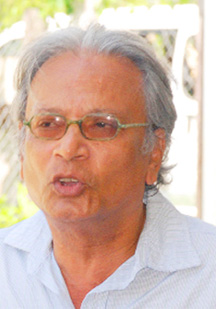Opposition leaders say that the administration should have consulted with them before setting up the panel to review the tax system.
President Donald Ramotar has appointed three persons to a panel he has set up to review the tax system. A Government Information Agency (GINA) statement on Saturday said that the president identified chartered accountant, Ronald Alli, economist Dr Cyril Solomon and businessman Clifford Reis who will constitute the panel to review the taxation system, and that they would begin their work shortly. GINA reported that in an interview with the state-owned NCN Ramotar said that the terms of reference had already been completed and had been sent to the members of the panel.
Comprehensive tax reform has long been called for by the opposition, the business community and others and in 2009, a Review of the Tax System was done under the US-funded Guyana Threshold Country Plan Implementation Project (GTCP/IP). It recommended staged reduction of the corporate tax to a uniform 30% over five years, along with the introduction of a withholding tax of 5% on dividend distributions, to make the economy more competitive and attract more private investment.

Contacted yesterday on the setting up of the tax review panel, Alliance For Change presidential candidate, Khemraj Ramjattan said that he welcomed the development but felt that in the spirit of consultations on the bigger issues, the opposition should have been consulted on the make-up of the panel. He stressed that he is not saying that the members identified are not qualified but given the fact that it is an important issue, their input should have been sought. “I support it fully” he said while calling it a useful development.
Ramjattan emphasized too that the panel should be granted the power to know where and what are the sources of revenue and to do a complete analysis of these sources since there would be no basis for genuine tax reform without knowing where all the revenue is coming from.

He also recalled the AFC’s position in relation to the Value Added Tax (VAT) saying that the tax was supposed to be revenue-neutral but has garnered revenue well above projections. He said that VAT ought to be reduced forthwith. “We don’t need a review of the tax system to do that,” he said.
Meantime, APNU executive Dr Rupert Roopnaraine in a brief comment said that the president would have been better advised to consult with the opposition.
Differentiated
According to the draft of the Review of the Tax System, prepared under the GTCP/IP in 2009, Guyana has high and highly differentiated tax rates on business income, ranging between a 45% rate on commercial companies, 35% on non-commercial companies and 33.3% on unincorporated businesses. What is more, it said there appears to be “no compelling economic or equity reasons” for corporate tax rate differences between commercial and non-commercial companies. It added that the tax differential can be expected to be undermined in cases of jointly-owned commercial and non-commercial companies. In fact, the review observed that owners have every incentive to allocate a disproportionate share of overhead costs and interest expenses to the commercial company to gain the benefit of tax deductions at the higher tax rate, effectively lowering the tax rate on the commercial company below 45%.
Ramjattan said that he expects that the recommendations of this review would be included in the new exercise.
The review recommended that the corporate tax rates be lowered and merged at 30% over a five-year period, noting that this would buy time to work on improving the general governance and lowering the costs of doing business in Guyana in a complementary fashion to the lowering of corporate tax rates. “This will minimise the revenues costs, while giving time for investment planning by business in response to an improved investment climate,” it said, adding that the success of the strategy would depend on the government sticking to its commitments to lower corporate tax rates.
The review noted that the higher tax rates in the corporate sector provide an incentive to conduct business in an unincorporated format rather than as a corporation as well as providing opportunities for tax arbitrage with the personal level for all closely held companies.
Recommending the reduction of the corporate tax to a standard 30% for both commercial and non-commercial companies, the review also urged the introduction of a 5% withholding tax on dividends paid to residents once the corporate tax rate is lowered below the top Marginal Income Tax Rate (MIR).
It recommended a staged reduction over a five-year period, arguing that the revenue cost could be reduced to more modest levels. It said the corporate tax rates cut should be announced ahead of time and all efforts made to improve the competitiveness of the Guyanese economy so that these corporate tax cuts attract added private investment.
If these measures are not taken, it noted, then the tax cost of the corporate cuts would be higher. The proposal involves lowering the 45% rate for commercial companies by three points a year and the 35% rate for non-commercial companies by one percentage point per year over five years. The review noted that the estimate of the initial 2009 cost would be $1.1 billion, rising to $2.5 billion by 2011 and declining to $1.6 billion by 2013.
The review said that after five years, the government can reassess the competitive position of the global market and decide whether or not to lower its rate any further, since 30% is still at the higher end of taxes internationally.
`Heavy burden’
A US-funded tax review had also recommended the reintroduction of a 20% tax bracket to reduce the “heavy burden” on middle-income earners. The 2009 review said that the current personal income tax (PIT) “places a significantly higher tax burden on personal income” than was the case between 1998 and 2005, when a 20% bracket was included alongside the current 33.3 flat rate. The 33.3% flat rate is charged on income above $35,000 a month or $420,000 a year. An amendment to the law has since seen this revised to $40 000 per month.
The review had noted that in addition to personal income tax, employment and self-employment income has to pay contributions to the National Insurance Scheme (NIS). As a result, on top of the income tax, the NIS requires employee contributions of 5.2% and employer contributions of 7.8% (or a combined 12.1% on the gross of employer contribution wage cost) up to a maximum monthly wage of $104,278 in 2007. “…[T]he combined PIT and NIS contributions place a heavy burden on middle-income employees between the threshold amount and the maximum contribution amount,” the review said, pointing out that the combined burden on the gross wage of these employees is about 45%, compared to 12% below the threshold and 33.3% above the maximum contribution amount.
The review said 50% of employees are below the threshold, 40% between the threshold and maximum contribution amount and the remaining 10% at higher incomes. By comparison, between 1998 and 2005, the personal income tax burden was lower and for those within the 20% tax bracket, the combined burden was 32%, though a small group was subjected to the combined 45% rate. “The imposition of this heavy burden on middle-income employee wages represents a major barrier to employment generation in this group,” the review had explained.
In this context, it has been recommended that “to reduce the tax burden on middle-income employees,” the 20% bracket should be reintroduced. Further, it said that the bracket should be expanded over five years until its upper band is the same as the annual maximum contribution limit for employees, at which point it should be sustained, equal to the NIS contribution limit. “This improves the equity of the individual income tax and removes a significant disincentive to job creation for middle-income earners,” it explained.
Bringing more self-employed into the tax net and reducing tax avoidance and evasion are also matters which have been on the tax reform agenda.



